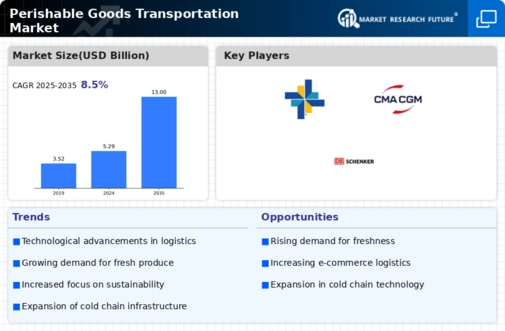Perishable Goods Transportation Size
Perishable Goods Transportation Market Growth Projections and Opportunities
The Perishable Goods Transportation Market is influenced by a myriad of factors that collectively shape its dynamics. A significant driver is the continuous growth of global trade in perishable goods, including fresh produce, pharmaceuticals, and perishable food products. With increasing demand for fresh and time-sensitive items, the need for specialized transportation services that ensure the efficient and timely delivery of perishable goods has risen. The agricultural sector, food industry, and pharmaceutical manufacturers heavily rely on such transportation services to maintain the quality and integrity of their products throughout the supply chain.
Technological advancements in transportation and logistics play a crucial role in shaping the Perishable Goods Transportation Market. The integration of advanced tracking and monitoring systems, refrigeration technologies, and real-time data analytics has enhanced the efficiency and reliability of perishable goods transportation. Innovations in temperature-controlled containers, telematics, and route optimization contribute to minimizing spoilage, reducing transit times, and ensuring the freshness of perishable products during transportation.
The globalization of supply chains and changing consumer preferences contribute to the growth of the Perishable Goods Transportation Market. As consumers seek access to a diverse range of fresh products year-round, regardless of seasonal availability, the transportation of perishable goods across long distances becomes essential. This trend is evident in the international trade of fruits, vegetables, seafood, and other temperature-sensitive items. The market is responsive to the evolving demands of consumers and the need for reliable transportation solutions that cater to the global supply chain.
Global economic conditions and trade dynamics significantly impact the Perishable Goods Transportation Market. Fluctuations in economic indicators, currency exchange rates, and trade policies can influence the demand for perishable goods transportation services. Economic stability, trade agreements, and geopolitical events play a crucial role in determining the accessibility and cost-effectiveness of transportation services for perishable goods on a global scale.
Environmental considerations, sustainability, and regulatory standards also shape the perishable goods transportation market. Stricter regulations regarding food safety, temperature control, and emissions contribute to the development of sustainable and environmentally friendly transportation practices. Compliance with these regulations is essential for transportation providers to ensure the safety and quality of perishable goods while minimizing the environmental impact of transportation operations.
Market competition and industry collaborations are noteworthy factors influencing the Perishable Goods Transportation Market. The market is characterized by a mix of transportation providers, logistics companies, and cold chain service providers. Collaboration within the industry supply chain, including partnerships between transportation providers, suppliers, and retailers, contributes to the development of comprehensive and efficient perishable goods transportation solutions. Continuous collaboration fosters innovations in packaging, handling practices, and transportation technologies to address the specific needs of perishable goods.
Challenges related to infrastructure, energy costs, and the need for specialized equipment are factors that the perishable goods transportation industry addresses. Adequate infrastructure, including refrigerated storage facilities and transportation networks, is crucial to maintaining the cold chain and ensuring the quality of perishable goods. Rising energy costs, particularly in the operation of refrigerated vehicles and facilities, pose challenges for cost-effective transportation solutions. The industry's focus on energy-efficient technologies and sustainable practices addresses these challenges and contributes to the overall efficiency of perishable goods transportation.







Leave a Comment